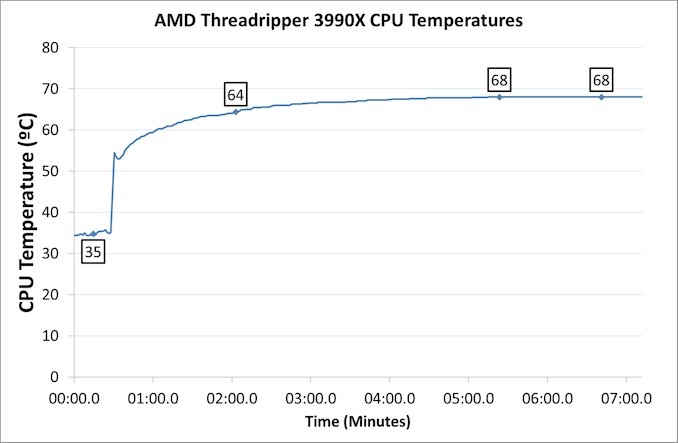The 64 Core Threadripper 3990X CPU Review: In The Midst Of Chaos, AMD Seeks Opportunity
by Dr. Ian Cutress & Gavin Bonshor on February 7, 2020 9:00 AM ESTFrequency, Temperature, and Power
A lot of questions will be asked about the frequency, temperature, and power of this chip: splitting 280W across all the cores might result in a low all-core frequency and require a super high current draw, or given recent reports of AMD CPUs not meeting their rated turbo frequencies. We wanted to put our data right here in the front half of the review to address this straight away.
We kept this test simple – we used our new NAMD benchmark, a molecular dynamics compute solver, which is an example workload for a system with this many cores. It’s a heavy all-core load that continually cycles around the ApoA1 test simulating as many picoseconds of molecular movement as possible. We run a frequency and thermal logger, left the system idle for 30 seconds to reach an idle steady state, and then fired up the benchmark until a steady state was reached.
For the frequencies we saw an ‘idle’ of ~3600 MHz, which then spiked to 4167 MHz when the test began, and average 3463 MHz across all cores over the first 6 minutes or so of the test. We saw a frequency low point of 2935 MHz, however in this context it’s the average that matters.
For thermals on the same benchmark, using our Thermaltake Riing 360 closed loop liquid cooler, we saw 35ºC reported on the CPU at idle, which rose to 64ºC after 90 seconds or so, and a steady state after five minutes at 68ºC. This is an ideal scenario, due to the system being on an open test bed, but the thing to note here is that despite the high overall power of the CPU, the power per core is not that high.
This is our usual test suite for per-core power, however I’ve condensed it horizontally as having all 64 cores is a bit much. At the low loads, we’re seeing the first few cores take 8-10W of power each, for 4.35 GHz, however at the other end of the scale, the CPUs are barely touching 3.0 W each, for 3.45 GHz. At this end of the spectrum, we’re definitely seeing AMD’s Zen 2 cores perform at a very efficient point, and that’s even without all 280 W, given that around 80-90W is required for the chipset and inter-chip infinity fabric: all 64 cores, running at almost 3.5 GHz, for around 200W. From this data, we need at least 20 cores active in order to hit the full 280W of the processor.
We can compare these values to other AMD Threadripper processors, as well as the high-end Ryzens:
| AMD Power/Frequency Comparison | |||||||
| AnandTech | Cores | CPU TDP | 1-Core Power |
1-Core Freq |
Full Load Power/core |
Full Load Freq |
|
| 3990X | 64 | 280 W | 10.4 W | 4350 | 3.0 W | 3450 | |
| 3970X | 32 | 280 W | 13.0 W | 4310 | 7.0 W | 3810 | |
| 3960X | 24 | 280 W | 13.5 W | 4400 | 8.6 W | 3950 | |
| 3950X | 16 | 105 W | 18.3 W | 4450 | 7.1 W | 3885 | |
The 3990X exhibits a much lower power-per-core value than any of the other CPUs, which means a lower per-core frequency, but it isn’t all that far off at all: less than half the power for only 400 MHz less. This is where the real efficiency of these CPUs comes into play.













279 Comments
View All Comments
nightmared - Friday, February 7, 2020 - link
While I have to admit Microsoft AD is fairly well integrated (with regards to features such as a folder redirections and GPOs) and coherent, there is alternatives (after all the core of AD resides in a "simple" LDAP server). The most compliant (because it is a re-implementation of the AD) is SAMBA4 and it works quite well. You can fairly easily manage a windows AD with it, free of charge (and it's open source, of course). Still not as pervasives as Microsoft AD with all its Powershell dedicated commands and its GUI managers.Whiteknight2020 - Friday, February 7, 2020 - link
But no group policy, integrated CA, recycle bin, DSC, third party ecosystem, gmsa etc. Not industrial strength, no support, no federation services....jospoortvliet - Saturday, February 8, 2020 - link
Check out Univention Corporate Server, they build quite the drop-in AD alternative.tuxRoller - Friday, February 7, 2020 - link
FreeipaWhiteknight2020 - Friday, February 7, 2020 - link
Is junk. Fundamentally badly designed, appalling to administer and weak on features. Nice try.tuxRoller - Wednesday, February 12, 2020 - link
Badly designed? Do you mean because it's mostly an orchestration tool?Whiteknight2020 - Friday, February 7, 2020 - link
RedHat have tried, but it's solution is pants. You can make Linux full citizens of AD with QAS though so you only need windows for the directory. Also does a nice job of certificate authority too.Chaitanya - Friday, February 7, 2020 - link
Many of my clients are running windows servers even in Datacentres.29a - Friday, February 7, 2020 - link
Lots.Hulk - Friday, February 7, 2020 - link
I like what AMD is doing. 8, 16, 24, 32, and 64 cores based on the same architecture. If you have the need for the compute and the cash they have you covered. Not to mention the fact that they've totally blown the lid off Intel's stratospheric pricing. If not for AMD I firmly believe 8 core parts would still cost $1000 or more.My next build is going to be my first AMD. Unless Intel can pull a rabbit out of their hat my next build is going to be my first AMD build.... and I've been building since the early 1990's.